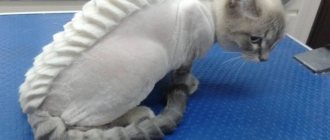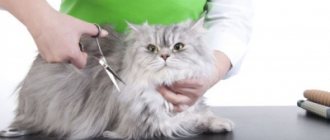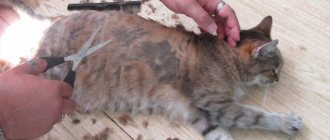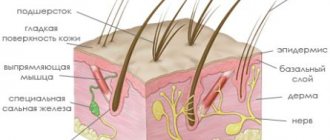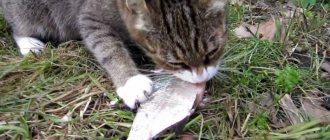The soft, velvety fur of a domestic cat is sometimes exciting to touch. Stroking a cat is a surprisingly pleasant and useful activity for both the owner and the animal. Every living creature enjoys being shown care and attention. However, it would be useful for a person to know how to stroke a cat correctly and when, so that it brings pleasure to both.
Why pet a cat?
Benefit to people
The presence of a four-legged furry in the house itself brings comfort and warmth. When a person returns home, he wants to leave the fuss, troubles, and irritating factors behind the threshold. After petting the cat, he feels a surge of positive emotions, relaxes, calms down, smoothly moving into the comfort zone. Accordingly, this has a positive effect on health - an accelerated pulse returns to normal, relaxation of muscles and vessel walls reduces high blood pressure, and stress goes away. As a result, sleep normalizes. The cat intuitively senses the owner’s mood and “understands” his state.
If a cat lay near a person’s sore spot and purred, the illness may go away.
What benefits does stroking give to four-legged animals?
For cats, such actions are an important part of the relationship. Despite their independent and proud disposition, they love affection, tenderness and attention. When a cat is caressed, the movements remind her of the sensation of being licked by her mother's tongue. From such manipulations, the animal seems to enter a state of light trance, remembering its childhood. In addition, the animal perceives stroking as a massage.
Useful tips
There are several rules regarding how to properly pet a cat:
- It is not advisable to pet a cat if he does not want to. Also, you cannot hold your pet by imposing your affection on him.
- Before you start petting, it is important to make sure that the cat is in a good mood. If the animal growls threateningly, its ears are flattened, and its tail flickers from side to side, then it is better to retreat. It is important for the pet to understand that his wishes are respected.
- You should not pet a frightened cat. Such a gesture will only increase her stress. It is better to talk to the animal in a quiet, measured voice. The cat will calm down faster, and the owner will have the opportunity to comfort him with gentle strokes.
- You should not pet your cat while eating, sleeping, or sitting in the litter box.
- Cats do not like eau de toilette and scented cosmetics. After using these means, it is better not to touch your pet.
- You cannot pet a cat while hanging over him with your body. Also, you should not look directly into his eyes for a long time. It is advisable to sit in a chair or on a sofa and wait for the animal to come and lie down next to you.
- Animals love to have their paws and pads stroked. But not all! These are very sensitive places. You need to touch them gently and carefully. If the cat is not delighted with such caresses, the owner will know about it immediately.
- The cat itself jumped onto your lap - a good sign. But you shouldn’t start petting her right away. Often she comes to lie relaxed on the warm lap of her owner and, when he starts petting her, she gets offended, jumps off and leaves.
- Before petting, it is useful to play interactive games with the cat (10-15 minutes), using 2-3 toys. The animal will warm up, release accumulated energy and negative emotions, and perhaps with gratitude and pleasure ask the owner for affection.
- You cannot pet a cat after punishment. She will regard this gesture as encouragement, a sign of weakness on the part of the owner. In the future, the animal will also misbehave and manipulate people.
- Sometimes cats rub against their legs. But this is not a call for stroking, as many people think. So he marks a person with a smell like “his territory.”
Information on how to properly pet cats will help you avoid many problems. Awareness will bring mutual pleasure and benefit to the human body who regularly caresses his pet.
When can you pet a cat?
An observant owner, knowing the temperament of his pet, sees when he wants affection and when it is better not to touch him.
At times the animal rubs against objects, taps its tail or purrs. This does not necessarily indicate that the kitten wants to be petted. In this way, the pet can show interest, greeting or irritation. An attentive owner, observing behavior, will know exactly when the animal is in a happy state and is ready to be petted. The main thing to remember is that this cute creature is not a plush toy, but a whole separate world with its own life cycle and desires.
Give them privacy
Respect your cat's personal space. As much as your cat enjoys hugs, there are times when your kitty just wants to be left alone. Therefore, it is important to respect your cat's personal space. Most cats just like to be alone for a bit from time to time.
The cat sleeps in his favorite bed
All cats will have different places to rest. You should pay attention to your kitten to learn his favorite places.
There are cats and cats that are “high-altitude climbers”))) It is simply vital for them to climb much higher.
Bastian is a fan of heights
How to iron correctly?
Conventionally, the owner’s behavior can be divided into the following stages:
- Before active actions, you need to warn the cat about your intentions by bringing your palm closer to its muzzle and allowing it to sniff.
- If the fluffy reacts calmly and rubs against your hand, then he is ready to continue.
- It is better to start gently stroking behind the ears, scratching the neck and chin. Gradually move from the head to the back.
- Each individual has favorite places for ironing, which the cat shows with all its appearance and asks for. Having identified these zones, there is no need to skimp on affection and tenderness.
- If a four-legged animal turns away, moves away, and begins to scratch, we must respect its “opinion” and freedom, and not cause more aggression. There is no need to touch a sleeping cat.
- Do not forcefully stroke an angry kitten with your hands, otherwise it will try to bite or scratch.
Correct assessment of the situation
In order to “guess” the right time for affection and expressions of love for your pet, you need to learn to understand its behavior:
- If a cat purrs and meows loudly, this does not mean that it is friendly. Pets do not change their behavior because of stroking or for the purpose of receiving additional affection and gaining human attention. Cats can become aggressive and irritable this way.
- If your pet jumps onto your lap on its own, it may be wanting to rest. In this case, the mustachios perceive the owner as a source of heat and warm themselves. They don't want to play or be petted.
- When in a playful mood, the cat will actively rub against its legs, poke its muzzle into its hands and touch them with its paws. The cat lies down next to the owner, begins to stretch out, curls up into a ball, begging for love. In this case, her actions cannot be ignored. Even when you are very busy, you can pet a cat for 1-2 minutes and strengthen your friendship.
Cats have a changeable and independent character, so they can only ask for short-term affection and do not crave long-term communication with humans.
At the same time, animals are vindictive and touchy. If you don't pet them, they will avoid their owner for a long time.
Also watch the video on how to properly pet a cat:
Pleasant areas for stroking
Head and back of the head
The favorite place to touch is the head, in particular, if you scratch behind the ear, you can hear a purr.
Almost all cats love affectionate touches on the head. Kittens remember that this is where their mother licked them. These pleasant sensations remain in the subconscious for life. Sitting comfortably on your hands or knees, the cutie will gratefully accept the love of his owners if he is scratched behind the ears and the back of his head. The cheeks are especially sensitive - the area behind the mustache below the eyes. By lightly patting this area, you can hear purring.
Breast and neck
With gentle movements of your fingers, moving from the chin to the neck, you can observe how the cat is pleased, and he stretches his neck forward, submitting his palms and squinting his eyes. These areas are located in such a way that it is difficult for a cat to comb them out on his own, so help is simply necessary here. He will not refuse several repetitions of the slow combing procedure, hinting at continuation.
Back and sides
Wide, gentle movements of the palm from the head to the base of the tail along the spine will demonstrate care. After all, such a massage relieves muscle spasms and stress on the back. Arching the body and rubbing the forehead on the hand encourages the owner to repeat what the cat liked. The paws remain controversial areas. Here the reaction may be different. It must be carefully clarified and conclusions drawn.
Interpretation in different dream books
In dream books from famous personalities, stroking a cat has the following meanings:
- Miller. Stroking a dirty and unkempt animal means serious troubles that will change the dreamer’s life for the worse. If in a dream you petted a purebred and fluffy cat, minor problems await you in the near future, which you can easily cope with on your own. For single people, such a dream symbolizes unrequited feelings or betrayal in a future relationship.
- Vanga. According to Vanga’s interpretation, stroking a cat most often means a deterioration in relationships with a loved one or problems at work. To avoid bankruptcy, it is recommended to take a closer look at your colleagues and manage your projects yourself. You should have a sincere conversation with your significant other - this will help identify existing problems and maintain harmony.
- Freud. Stroking a furry pet, according to a famous psychologist, symbolizes the desire for intimacy on a subconscious level. Also, such a night vision can warn of betrayal of a loved one, strong jealousy or a short love affair that will leave the dreamer with negative emotions.
- Nostradamus. In the dream book of Michel Nostradamus, stroking a cat means ingratitude or betrayal of one of the family members. If in a dream you caressed many little kittens that purr with pleasure, an influential person will appear in real life, and he will become a support in all your endeavors.
- Meneghetti. Monotonously stroking a pet means there is an energy vampire in your immediate environment. The presence of this person provokes a deterioration in the psychological and physiological state of the dreamer, so it is recommended to identify this person as soon as possible.
- Hasse. The medium warns that petting a cat in a dream is a sign of excessive gullibility in real life. To achieve success in future projects, you need to learn to understand your colleagues and not let employees know your ideas. If the animal looks sick, you need to pay more attention to your family, as they are in dire need of your support.
- Medea. A dream in which you stroke a cat warns of the onset of a black streak. In the near future, all the dreamer’s actions will be negatively perceived by people around him, so it is recommended to refuse drastic changes in work or personal life. The sorceress recommends taking a short vacation and spending it alone with yourself.
Each person has a different attitude towards cats and cats, but the appearance of the image of this animal in a dream often warns of possible troubles or drastic life changes. To avoid negative consequences, it is recommended to listen carefully to the sensations caused by the dream and try to avoid rash actions.
Why can't you pet your tail?
This part of the body is responsible for several functions:
It is not recommended to touch the tail, as it contains nerve endings and touching it causes discomfort to the animal.
- coordinates movements;
- shows the emotional state of the moment;
- In some breeds it serves for additional heating.
It is not recommended to stroke the tail and its base. Touching causes irritation, nervous movements, and sometimes outright aggression or an attempt to claw at the animal. There are many nerve endings passing through here, and their activation brings considerable discomfort to the animal. The back can be stroked only to the base of the tail, without trying to touch it.
Where should you not touch a cat?
If the pet lies on its back, showing a soft belly, then it shows complete trust and openness. This is a very vulnerable area and is available for petting only after the invitation and permission of the cat. He doesn't like patting his belly and is more likely to lead to play with biting and scratching. Do not move in the direction opposite to hair growth, lifting the hair with force.
You should not stroke your cat against the grain, as this causes pain, especially in short-haired cats.
A defensive reaction occurs instinctively - the cat attacks, bites, scratches, and sometimes hisses. Any representative of the cat family would not want to feel discomfort from touching the delicate and sensitive ears. The ears help to choose the direction of movement. They are equipped with a rich nervous network. Even a light breeze causes the cat to shake its ears.

